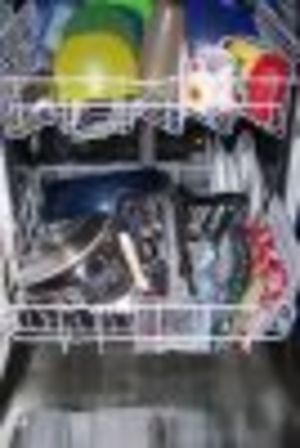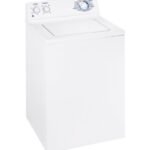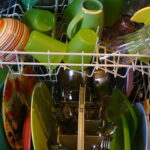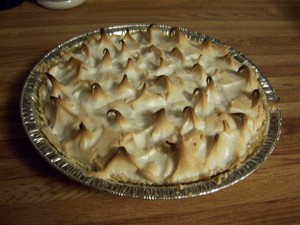When you go shopping for a new dishwasher, what do you look for? Of course, energy-efficiency is one thing, but there are other important features that you must consider.
Initial costs for the washer can run from $380 to $1550. That extra $1170 could pay for a lot of gas or electric over the life of the machine.
For years, there have been government-mandated labels on all new appliances to give consumers important basic information. The yellow “Energy Guide” tags will give comparisons – among similar products – in annual energy usage, among other facts. The number is based on standard US government tests, and the tag also gives an estimated yearly operating cost for a particular model. Of course, you will want to choose the most efficient one – for your purposes.
In its annual Buying Guide for 2009, Consumers Union states it offers its own “energy usage scores,” which rates from “excellent” to “fair,” based on dirtier loads.” Look for a copy in your local library.
However, you will also want to consider the original purchase cost, how well the machine works, its brand repair history, along with the features that are important to you.
What size washer is good for your family? We’re always told to run a washer only after it’s full. For small families, that might be every second day. For larger, it could be twice a day.
Using an automatic washer in itself will save water over hand washing dishes, pans, and utensils. Some washers offer a pre-rinse cycle, but that can use an extra 6500 gallons of water a year. Wash cycles range from 100 to 145 minutes. In fact, some last 180 minutes “to help improve cleaning as energy standards get stricter.” Although being more energy-efficient and using less water require a longer wash time to be effective, the longest were not necessarily better.
Using a good enzyme detergent (to “digest” and remove food particles) and a good rinse agent will make any washer clean more effectively. Some detergents wash well without the use of phosphates, which are not environmentally friendly. The 2009 Guide states some of the best detergents tested were Ecover, Citra Dish, 365 Everyday Value, and Seventh Generation.
If you’re going to spend hundreds on a washer, you expect it to last for a few years, and you’ll want to consider some important features.
Some new washers are touting “steam cleaning.” They don’t clean any better than much cheaper machines. However, you might like “targeted spray jets,” which help blast away dried food particles. (Note: this feature didn’t improve cleaning over the top-rated washers without this option.)
If a washer is going to run for two hours or more, noise might be a big consideration for you. If it’s in a busy kitchen, you might want to choose a quieter machine. If it’s near the baby’s room or your own bedroom, and you want to run the washer after you go to bed, quietness could be important to you.
“Soil sensors” will adjust water use and cycle times to improve energy and efficiency.The “rinse/hold” cycle will do a quick rinse and “hold” them while waiting to be washed on a full cycle later.
Adjustable dish racks can make life easier. If you have tall glasses, large dishes, or big pots, being able to raise and lower the upper shelf will make a difference to you. Some new washers have the silverware rack on top.
Some washers offer self-cleaning filters, via grinders, which rather noisily dispose of food particles. All offer filters so food isn’t redeposited on dishes. Some have filters that must be cleaned manually.
The sprayers are set at multi-levels for more efficient cleaning. Some machines offer a “delay start” program. Some models offer electronic touchpad controls, which are easy to clean. Some show the amount of cleaning time left; others don’t.
Utensil holders come in different sizes and user guides usually recommend that silverware be loaded handles down except for knives. Some have slots for individual utensils, which can prevent “spooning” in which similar utensils cling to one another and don’t clean properly. Slots might appeal to you, but some people find them less convenient to use than open holders.
Stainless-steel interiors can take quite a beating and still look good, but don’t affect cleaning performance. Most washers offer a stainless-steel exterior as a choice, but there are also color choices and glass exteriors, which could cost $100 to $200 more.
Of course, you buy a washer to wash dishes. Cleaning is a top priority. Energy use is also important. You also want to consider how easy a washer is to load; its noise level; the ease of loading bulky items; the ease of using the controls; and the average amount of time it takes to wash a full load.
Some washers offer a “temperature boost” option (which is great if someone is “germy” with a cold or flu), and most offer a heated-dry cycle, which you can turn off to save even more energy, time, and money.
A top-quality washer should be expected to wash effectively, and rate well for energy-use, noise and ease of use.
According to the August 2009 Consumer Reports, the 10 top-rated washers (out of 45 tested) with these features range in price from $720 to $1600. The top-rated Bosch (model SHX98M0[9]UC) cost $1550; three high-rated Kenmores (including an “Elite Ultrawash HE” sells for $1380, the “Kenmore Pro” costs $1280, and the Kenmore model 1374[2], which sells for $720 – rated a “best buy”) are among the top 10.
Two more “best buys” are the Bosch model SHE33M0[2]UC for $600, and the Whirlpool Gold model GU2300XTV[Q] for $550, rated numbers 15 and 19 respectively. Two of the lower-priced “recommended” models are the Kenmore model 1389 for $500 and the Whirlpool DU1055XTV[Q] for $400, rated 18 and 24 respectively.
The top-ranked also required fewer repairs over a four-year period, averaging about 8% to 9% that required repairs as compared with 15% of Maytags and 23% of Fisher and Paykels.
Once you’ve narrowed down your choices, look for “Energy Star” labels – a white logo on a blue background – which mark specific models of products that are recognized for energy-efficiency. The U.S. Environmental Protection Program and the Department of Energy back the program.
Beginning in August 2009, the washers that earn the labels must use no more than 5.8 gallons of water per cycle, and they must have an energy factor above 0.65, with an electric water heater. They must not use more than 324 kilowatt-hours per year, which will make them about 32% more effective than existing models.
Some online stores, like Lowes.com, also offer up-to-date consumer ratings from their customers. Such ratings are particularly helpful for recently manufactured products that haven’t yet been rated by Consumer Reports.
Before making a major purchase, check out the August 2009 issue of Consumer Reports for comparisons of 45 specific models of washers, retail costs, most-wanted features, and a report on brand-repair history.
Sources:
Consumer Reports, “Dishwashers: Good values abound and energy use drops,” August 2009, published by Consumers Union. Tested products and ratings.
Consumer Reports Buying Guide 2009, published by Consumers Union. General information about dishwashers.
www.Lowes.com. Site offers a selection of products and prices with consumer feedback on purchased products.





